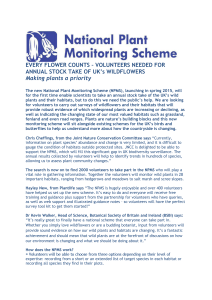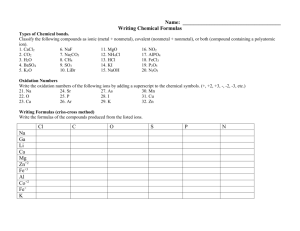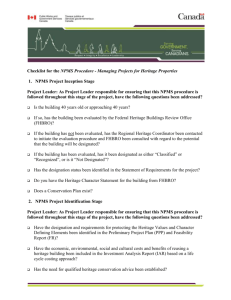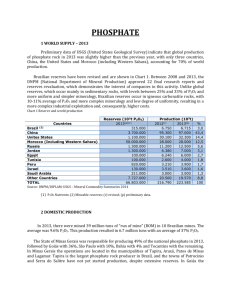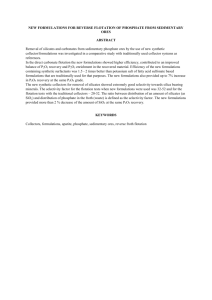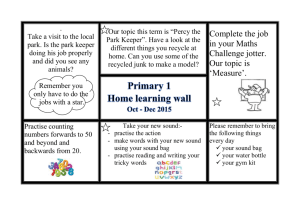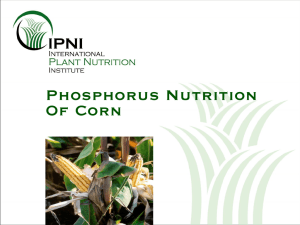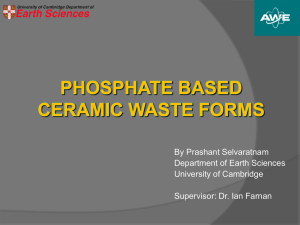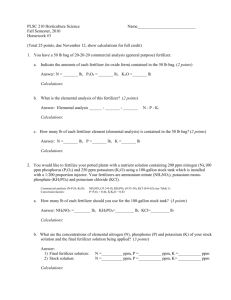1.0Introduction - University of Southampton
advertisement
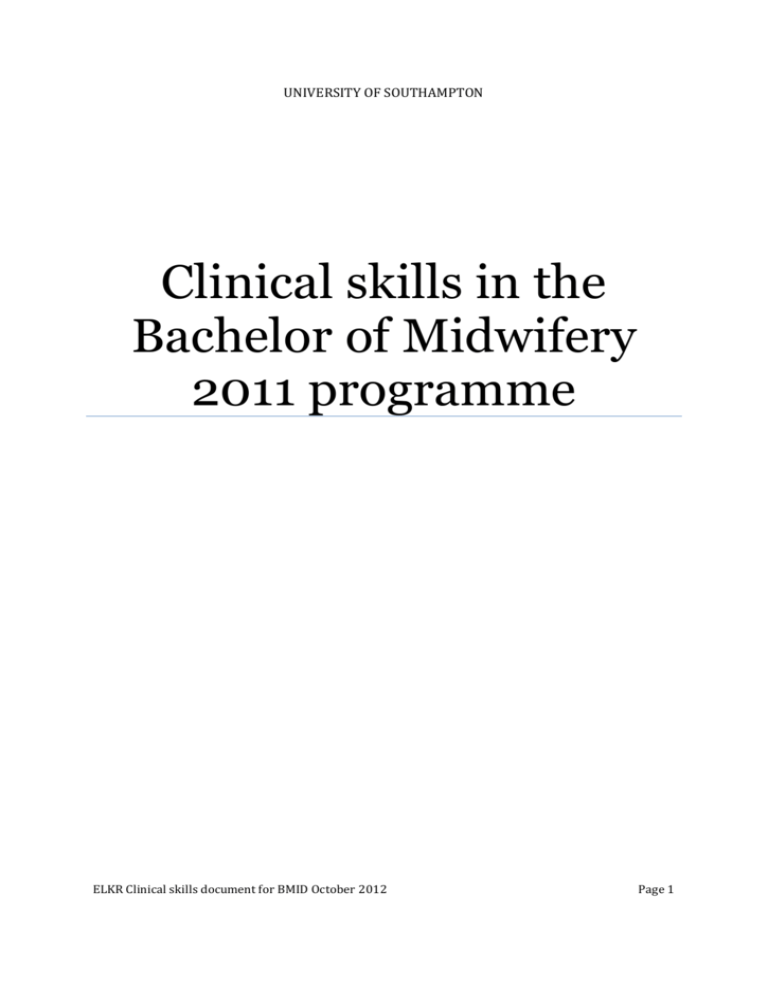
UNIVERSITY OF SOUTHAMPTON Clinical skills in the Bachelor of Midwifery 2011 programme ELKR Clinical skills document for BMID October 2012 Page 1 Table of Contents 1.0 Introduction ......................................................................................................................... 3 2.0 Part 1 .................................................................................................................................... 5 1.1 3.0 At a glance skills taught in practice by midwifery teaching team ............................13 Part 2 ..................................................................................................................................14 Fire Lectures ...............................................................................................................................14 Drug Calculation Tests ...........................................................................................................14 Drug assessments ...................................................................................................................15 CTG Sessions ............................................................................................................................15 Blood transfusion updates .....................................................................................................15 Moving and Handling Training ..............................................................................................16 Manual Handling Updates ......................................................................................................16 Neonatal Resuscitation ...........................................................................................................17 Infant Basic Life Support ........................................................................................................17 Child Basic Life Support ..........................................................................................................17 Adult Basic Life Support/Maternal Resuscitation ..............................................................17 ELKR Clinical skills document for BMID October 2012 Page 2 1.0 Introduction The skills presented within this document are based on feedback from stakeholders, South Central Strategic Health Authority Statutory and Mandatory Framework* and the NMC Standards for preregistration midwifery. These skills are included explicitly within the 2011 curriculum linked to specific theoretical modules and/or practice experience modules. Part 1of this document presents the statutory and mandatory skills in relation to the modules within years 1 and 2. Our midwifery practice partners have been involved in identifying skills and considering their delivery throughout the three practice years in either the skills log or module content. The additional skills were identified in conjunction with the essential skills cluster, to form the skills log. Part 2 of this document presents the skills log with relation to the theory, skills rehearsal in academia and skills carried out in practice settings. The programme calendar is currently being developed to complete the third year of the curriculum. The three years comprise the following modules; Year 1 NPMS 1012: Midwifery Care in Pregnancy and Childbirth NPMS 1016: Foundations of Health Sciences NPMS 1013: Postnatal mother, baby and family NPCG 1016: Applied Health Sciences NPMS 1014: Practice experience 1 (PE1) NPMS 1015: Practice experience 2 (PE2) Year 2 NPMS 2014: Responding to complex need during the antenatal period NPMS 2015: Responding to complex needs during the Intrapartum period NPMS 2028: Partnerships NPMS 2016: Responding to complex needs during the postpartum and neonatal period NPMS 2017: Practice experience 3 (PE3) NPMS 2018: Practice experience 4 (PE4) Year 3 Module codes to be confirmed The contemporary midwife practitioner Research Leadership and management Practice experience 5 (PE5) Practice experience 6 (PE6) ELKR Clinical skills document for BMID October 2012 Page 3 In summary, this means that students will have achieved all of the skills marked by * prior to practice experience 1 and will receive yearly updates of these skills as appropriate and as indicated in the part 1. This information will be made available on the ALPS website to support mentors and students in practice. These skills are for information only and may be subject to change. There will be the opportunity in the near future that these will be linked with the electronic AOP. A principle to be agreed is that students can access Trust training for certain skills if their mentor believes that this would be a useful addition to the student’s portfolio. Unlike the NMC standards for nursing, the midwifery programme cannot use simulated practice as part of practice hours therefore skills are being taught in practice with the support from academic tutors with Technology Enhanced Learning facilities and theory within the taught component of the programme (this will be indicated below). ELKR Clinical skills document for BMID October 2012 Page 4 2.0 Part 1 Skill Theory taught (in Faculty) some skills are attached to practice modules although the theory will be taught within the students theory blocks Skills rehearsal an initial skills rehearsal will be undertaken within the students theory time or during first week in practice whereby the midwifery teaching team will accompany students in practice for teaching purposes. Skills will also be required throughout the practice placements Infection prevention and control* NPMS 1012: Midwifery Care in Pregnancy and Childbirth NPMS 1014: Practice experience 1 (PE1) Health and safety* Programme induction As part of the initial induction to practice on the clinical induction days PE1, 3 and 5 Moving and handling* NPMS 1014: Practice experience 1 (PE1) NPMS 1014: Practice experience 1 (PE1) and PAH Trust induction NPMS 1012: Midwifery Care in Pregnancy and Childbirth Equality, human rights and diversity* NPMS 1012: Midwifery Care in Pregnancy and Childbirth NA Conflict resolution* NPMS 1012: Midwifery Care in Pregnancy and Childbirth NA Resuscitation* to include neonatal resuscitation NPMS 1014: Practice experience 1 (PE1) NPMS 1014: Practice experience 1 (PE1) NPMS 1012: Midwifery Care in Pregnancy and Childbirth ELKR Clinical skills document for BMID October 2012 These are mandatory and will be revisited yearly Year 1 –prior to practice experience 1 Page 5 Safeguarding* NPMS 1012: Midwifery Care in Pregnancy and Childbirth NPMS 1012: Midwifery Care in Pregnancy and Childbirth NA Abdominal palpation, placenta, fundus/involution, equipment for birth, completion of partogram and normal birth pathway NPMS 1012: Midwifery Care in Pregnancy and Childbirth NPMS 1014: Practice experience 1 (PE1) Venesection NPMS 1014: Practice experience 1 (PE1) NPMS 1014: Practice experience 1 (PE1) Resuscitaire and home birth bags/equipment NPMS 1012: Midwifery Care in Pregnancy and Childbirth NPMS 1014: Practice experience 1 (PE1) MEOWS, BP, Temp, Pulse, urinalysis, ANTT, putting on gloves ELKR Clinical skills document for BMID October 2012 NPMS 1014: Practice experience 1 (PE1) Page 6 Year 1 –prior to practice experience 2 Skill Theory taught (in Faculty) some skills are attached to practice modules although the theory will be taught within the students theory blocks Skills rehearsal an initial skills rehearsal will be undertaken within the students theory time but they will be expected to practice within the practice modules Aseptic technique NPMS 1013: Postnatal mother, baby and family NPMS 1015: Practice experience 2 (PE2) As part of ANTT Intermittent auscultation and CTG interpretation NPMS 1012: Midwifery Care in Pregnancy and Childbirth Input from the supervisors of midwives Birth planning Record keeping NPMS 1014: Practice experience 1 (PE1) NPMS 1015: Practice experience 2 (PE2) Includes practice update from the SoM team NPMS 1012: Midwifery Care in Pregnancy and Childbirth NPMS 1014: Practice experience 1 (PE1) NPMS 1012: Midwifery Care in Pregnancy and Childbirth NPMS 1014: Practice experience 1 (PE1) NPMS 1015: Practice experience 2 (PE2) NPMS 1015: Practice experience 2 (PE2) Includes practice update from the SoM team Injection technique NPMS 1015: Practice experience 2 (PE2) NPMS 1015: Practice experience 2 (PE2) Drug calculations – covered with an invigilated exam where the pass mark is 100% NPMS 1012: Midwifery Care in Pregnancy and Childbirth / NPCG 1016: Applied Health Sciences NPMS 1012: Midwifery Care in Pregnancy and Childbirth NPMS 1012: Midwifery Care in Pregnancy and Childbirth / NPCG 1016: Applied Health Sciences NPMS 1015: Practice experience 2 (PE2) Medicines management – needs further definition – progression needs to be evidenced in terms of student responsibility and ELKR Clinical skills document for BMID October 2012 NPCG 1016: Applied Health Sciences Page 7 achievement Midwifery students – year 2 PE3 Skill Theory taught (in Faculty) some skills are attached to practice modules although the theory will be taught within the students theory blocks Skills rehearsal an initial skills rehearsal will be undertaken within the students theory time but they will be expected to practice within the practice modules Mandatory skills NPMS 2017: Practice experience 3 (PE3) NPMS 2017: Practice experience 3 (PE3) NPMS 2015: Responding to complex needs during the Intrapartum period Health and safety* NPMS 2017: Practice experience 3 (PE3) NPMS 2017: Practice experience 3 (PE3) Moving and handling* NPMS 2017: Practice experience 3 (PE3) NPMS 2017: Practice experience 3 (PE3) and PAH Trust induction NPMS 2017: Practice experience 3 (PE3) Equality, human rights and diversity* NPMS 2017: Practice experience 3 (PE3) NA Conflict resolution* NPMS 2017: Practice experience 3 (PE3) NA Resuscitation* to include neonatal resuscitation NPMS 2017: Practice experience 3 (PE3) NPMS 2017: Practice experience 3 (PE3) Safeguarding* NPMS 2028: Partnerships NPMS 2015: Responding to complex needs during the Intrapartum period ELKR Clinical skills document for BMID October 2012 NPMS 2017: Practice experience 3 (PE3) These are mandatory and will be revisited yearly Infection prevention and control* Page 8 Recognising the deteriorating patient NPMS 2015: Responding to complex needs during the Intrapartum period NPMS 2015: Responding to complex needs during the Intrapartum period NPMS 2018: Practice experience 4 (PE4) Acuity skills/MEOWS NPMS 2015: Responding to complex needs during the Intrapartum period NPMS 2018: Practice experience 4 (PE4) Medicines administration and management including intravenous infusions and blood transfusions NPMS 2015: Responding to complex needs during the Intrapartum period NPMS 2018: Practice experience 4 (PE4) Drug calculations NPMS 2016: Responding to complex needs during the postpartum and neonatal period NPMS 2018: Practice experience 4 (PE4) Naso gastric feeding NPMS 2016: Responding to complex needs during the postpartum and neonatal period NPMS 2016: Responding to complex needs during the postpartum and neonatal period NPMS 2018: Practice experience 4 (PE4) Bi-PAP and CPAP – observation as part of NN unit placement NPMS 2016: Responding to complex needs during the postpartum and neonatal period NPMS 2016: Responding to complex needs during the postpartum and neonatal period NPMS 2018: Practice experience 4 (PE4) Record keeping – as part of module content NPMS 2014: Responding to complex need during the antenatal period NPMS 2017: Practice experience 3 (PE3) NPMS 2018: Practice experience 4 (PE4) NPMS 2015: Responding to complex needs during the Intrapartum period NPMS 2016: Responding to complex needs during the postpartum and neonatal period Drug round, workshop, drug charts and booklet NPMS 2016: Responding to complex needs during the postpartum and neonatal period ELKR Clinical skills document for BMID October 2012 NPMS 2017: Practice experience 3 (PE3) Page 9 NPMS 2018: Practice experience 4 (PE4) Partograms – action and alert lines Risk assessment – as part of module content NPMS 2015: Responding to complex needs during the Intrapartum period NPMS 2017: Practice experience 3 (PE3) NPMS 2014: Responding to complex need during the antenatal period NPMS 2017: Practice experience 3 (PE3) NPMS 2018: Practice experience 4 (PE4) NPMS 2018: Practice experience 4 (PE4) NPMS 2015: Responding to complex needs during the Intrapartum period Oedema Catheterisation and catheter care/fluid balance Injection technique NPMS 2016: Responding to complex needs during the postpartum and neonatal period NPMS 2014: Responding to complex need during the antenatal period NPMS 2017: Practice experience 3 (PE3) NPMS 2018: Practice experience 4 (PE4) NPMS 2015: Responding to complex needs during the Intrapartum period NPMS 2017: Practice experience 3 (PE3) NPMS 2017: Practice experience 3 (PE3) NPMS 2017: Practice experience 3 (PE3) NPMS 2018: Practice experience 4 (PE4) NPMS 2018: Practice experience 4 (PE4) ELKR Clinical skills document for BMID October 2012 Page 10 Midwifery students – year 2 PE4 Skill Theory taught (in Faculty) some skills are attached to practice modules although the theory will be taught within the students theory blocks Skills rehearsal an initial skills rehearsal will be undertaken within the students theory time but they will be expected to practice within the practice modules. PE 3 and 4 are high risk placements. Half the cohort are on delivery suite whilst the other half are in the antenatal and postnatal wards. They then swap. CTG and IA NPMS 2015: Responding to complex needs during the Intrapartum period NPMS 2017: Practice experience 3 (PE3) Input from the supervisors of midwives Sepsis NPMS 2014: Responding to complex need during the antenatal period NPMS 2018: Practice experience 4 (PE4) Includes practice update from the SoM team NPMS 2017: Practice experience 3 (PE3) NPMS 2018: Practice experience 4 (PE4) NPMS 2015: Responding to complex needs during the Intrapartum period NPMS 2016: Responding to complex needs during the postpartum and neonatal period Glucose monitoring NPMS 2015: Responding to complex needs during the Intrapartum period NPMS 2017: Practice experience 3 (PE3) NPMS 2018: Practice experience 4 (PE4) NPMS 2016: Responding to complex needs during the postpartum and neonatal period Vaginal examination NPMS 2015: Responding to complex needs during the Intrapartum period ELKR Clinical skills document for BMID October 2012 NPMS 2017: Practice experience 3 (PE3) Page 11 NPMS 2018: Practice experience 4 (PE4) DVT/PE = VTE Passing urine Jaundice baby assessment The unwell woman Pressure area care Perineal assessment/checking Wound care NPMS 2016: Responding to complex needs during the postpartum and neonatal period NPMS 2017: Practice experience 3 (PE3) NPMS 2015: Responding to complex needs during the Intrapartum period NPMS 2017: Practice experience 3 (PE3) NPMS 2016: Responding to complex needs during the postpartum and neonatal period NPMS 2017: Practice experience 3 (PE3) NPMS 2015: Responding to complex needs during the Intrapartum period NPMS 2017: Practice experience 3 (PE3) NPMS 2015: Responding to complex needs during the Intrapartum period NPMS 2017: Practice experience 3 (PE3) NPMS 2015: Responding to complex needs during the Intrapartum period NPMS 2017: Practice experience 3 (PE3) NPMS 2016: Responding to complex needs during the postpartum and neonatal period NPMS 2017: Practice experience 3 (PE3) ELKR Clinical skills document for BMID October 2012 NPMS 2018: Practice experience 4 (PE4) NPMS 2018: Practice experience 4 (PE4) NPMS 2018: Practice experience 4 (PE4) NPMS 2018: Practice experience 4 (PE4) NPMS 2018: Practice experience 4 (PE4) NPMS 2018: Practice experience 4 (PE4) NPMS 2018: Practice experience 4 (PE4) Page 12 2.1 At a glance skills taught in practice by midwifery teaching team Year 1 Year 2 NN resuscitation Skills for PE3 Skills for PE1 Documentation Drug round Drugs form/booklet Drug round workshop Partograms – action and alert lines Risk assessment Oedema Drug charts Catheterisation Injection technique MEOWS Bp Temp Pulse Resp ANTT Abdominal palpation Placenta Fundus/involution Risk assessment Equipment for birth Gloves CTG and intermittent auscultation Urinalysis Sepsis Partogram – normal birth pathways ANTT Venesection Glucose monitoring Lucky dip bag VE Neonatal resuscitation – introduction DVT/PE =VTE to resuscitaire Passing urine Assessment jaundiced baby Neonatal resuscitation Unwell woman Pressure area care Perineal assessment/checking Skills for PE2 MEOWS Risk assessment Drugs – terminology / community Intermittent auscultation and CTG Skills for PE4 interpretation – differences Birth planning Record keeping ELKR Clinical skills document for BMID October 2012 Page 13 3.0 Part 2 Record of training and updates taken from the AoP. For the purposes of this section of the document, year three considers the final year of the outgoing curriculum and may alter with the new 2011 curriculum Fire Lectures Year Theory Skills Practice only rehearsal academic Year 1 On line Statutory and mandatory n/a PAH Trust mandatory training for students Year 2 On line Statutory and mandatory Year 3 n/a PAH Trust mandatory training for students n/a PAH Trust mandatory training for students *Infection prevention and control/Standard precautions (including handwashing) Year Theory Skills Practice only rehearsal academic Year 1 NPMS 1014 – PE1 n/a ANTT PAH Trust mandatory training for students Year 2 NPMS 2017 – PE3 n/a ANTT PAH Trust mandatory training for students Year 3 n/a n/a PE 5 ANTT PAH Trust mandatory training for students Drug Calculation Tests Year Theory Skills rehearsal - academic Practice only Year 1 NPMS 1012 Online self test n/a Year 2 NPMS 2016 Online self test n/a Year 3 NPMS 3016 Online self test n/a ELKR Clinical skills document for BMID October 2012 Page 14 Drug assessments Year Theory Skills rehearsal - academic Practice only Year 2 n/a n/a NPMS 2018 – PE4 Year 3 n/a n/a PE 6 CTG Sessions Year Lecture/training Theory Skills rehearsal Practice only - academic Year 1 Interpretation of normal CTGs NPMS 1012 n/a NPMS 1014/1015 – PE1 and 2 Year 2 Interpretation of abnormal CTGs NPMS 2015 n/a NPMS 2017/2018 – PE 3 and 4 Year 3 K2 n/a Via Trust K2 PE 5 and 6 access Blood transfusion updates Year Theory Skills rehearsal - academic Practice only Year 2 n/a NPMS 2014 online National Blood transfusion – Observation module 1 Year 3 n/a NPMS 3015 online National Blood transfusion – Observation module 1 ELKR Clinical skills document for BMID October 2012 Page 15 Moving and Handling Training Session Theory Skills rehearsal - academic Practice only Lecture 1 On line Statutory and mandatory n/a n/a On line Statutory and mandatory n/a n/a n/a n/a Law and Legislation On line PAH Trust mandatory training for students Interactive Video n/a On line Statutory and mandatory n/a Practice Session n/a Statutory and mandatory PAH Trust Complications of Immobility Lecture 2 Moving and Handling in Daily Life Lecture 3 mandatory training for students PE 1 Manual Handling Updates Year Theory Skills rehearsal - academic Practice only Year 2 PAH Trust mandatory training for students n/a PAH Trust mandatory training for students PE3 Year 3 PAH Trust mandatory training for students n/a PAH Trust mandatory training for students PE5 ELKR Clinical skills document for BMID October 2012 Page 16 Neonatal Resuscitation Year Theory Skills rehearsal - academic Practice only Year 1 n/a NPMS 1014 – PE1 n/a Year 2 n/a NPMS 2016 n/a Year 3 n/a NPMS 3015 n/a Infant Basic Life Support Year Theory Skills rehearsal - academic Practice only Year 1 n/a NPMS 1014 – PE1 n/a Year 2 n/a NPMS 2014 n/a Year 3 n/a NPMS 3015 n/a Child Basic Life Support Year Theory Skills rehearsal - academic Practice only Year 1 n/a NPMS 1014 – PE1 n/a Year 2 n/a NPMS 2014 n/a Year 3 n/a NPMS 3015 n/a Adult Basic Life Support/Maternal Resuscitation Year Theory Skills rehearsal - academic Practice only Year 1 n/a NPMS 1014 – PE1 n/a Year 2 n/a NPMS 2014 n/a Year 3 n/a NPMS 3015 including maternal resus n/a ELKR Clinical skills document for BMID October 2012 Page 17 Prevention of cross infection √ Disposal of sharps √ √ Practice only practise Theory and Skills academic Theory Practice only practise Theory and Skills academic Theory Practice only practise Theory and Skills academic Year 1 Theory Nursing skills √ √ √ Temperature √ √ √ Pulse √ √ √ Respiration √ √ √ Blood pressure √ √ √ √ √ √ √ √ √ √ √ Bed making Urinalysis √ √ Collection of urine sample including mid stream sample Aseptic technique √ √ Vulval care √ √ √ Use of bidet √ √ √ Comfort during period of immobility √ √ √ Observation of skin colour √ √ Assessment of oedema √ √ Collection of stool sample ELKR Clinical skills document for BMID October 2012 √ √ Page 18 √ Collection of wound swab √ Pressure sore prevention √ √ Oral care √ √ Personal hygiene needs i.e. blanket bath, only Practice practise Theory and academic Skills Theory only Practice practise Theory and Year Three academic Skills Theory only Practice practise Theory and Year Two academic Skills Year One Theory Nursing Skills √ √ care of hair etc √ Maternal blood sugar measurement √ Examination of stools √ √ Examination of vomit √ √ Examination of discharge (PV, wound etc) √ √ Recognition of signs of infection (e.g. √ √ √ pyrexia, tachycardia, tachypnoea, vomiting diarrhoea) Examination of wound healing √ √ Catheter care √ √ Care of blood transfusion √ Catheterisation √ ELKR Clinical skills document for BMID October 2012 √ √ Page 19 Removal of wound drains √ √ Removal of wound sutures/clips √ √ Pre-operative preparation/care √ √ Immediate post operative recovery √ √ Post-operative care √ Care of the unconscious/semi-conscious √ √ √ patient √ Escort duties e.g. X-ray/Ultrasound Practice only practise Theory and Skills academic Theory Practice only practise Theory and Year Three Skills academic Theory Practice only practise Theory and Year Two Skills academic Year One Theory Nursing Skills √ Administer intramuscular injections √ √ Administer subcutaneous injections √ √ Administration of insulin √ Maintenance of fluid balance charts √ Administration of oral medicine √ √ √ √ Administration of medicine per rectum √ √ Role of second practitioner in relation to drug √ √ administration ELKR Clinical skills document for BMID October 2012 Page 20 √ Conduct a drug round √ √ Principles of record keeping in relation to drug √ administration √ Drug policy and drug use in the community √ √ Order, receive, store and dispose of medicinal products safely, including controlled drugs √ Prompt action and reporting of adverse incidents, near misses and adverse drug reactions √ Assess signs and symptoms of shock Diagnosis of pregnancy Calculate estimated date of delivery (EDD) Initial consultation (Booking interview) √ Practice only practise Theory and Skills academic Theory Practice only practise Year Three Theory and Skills academic Theory Practice only practise Theory and Year Two Skills academic Year One Theory Antenatal Skills √ √ √ √ √ √ √ √ √ √ √ √ √ √ √ Calculation of body mass index (Weight (Kg)/Height (m)2) Assessment of weight gain in pregnancy Assessment of psychological needs √ √ √ Assessment of risk √ √ √ ELKR Clinical skills document for BMID October 2012 Page 21 √ Provision of opportunities for disclosure of √ √ domestic violence/sexual abuse Abdominal examination in pregnancy √ √ √ √ Assessment of fundal height √ √ √ √ Auscultation of fetal heart with Pinard √ √ √ √ √ √ √ √ √ √ √ √ stethoscope √ Shares information and facilitates choice on √ Practice only practise Theory and Skills academic practise Theory and Year Three Skills academic Theory Practice only practise Theory and Year Two Skills academic Year One Theory Antenatal Skills √ Theory Provide advice on nutrition Practice only Auscultation of fetal heart with sonic aid √ √ √ √ √ √ examinations for diagnosis of pregnancy at risk Antenatal blood tests √ Interpretation of test results, including sensitive √ √ sharing and discussion with women Monitor Rhesus negative women √ √ Administer Anti-D immunoglobulin √ √ Venepuncture Plan a care pathway in partnership with women Support women in determining place of birth ELKR Clinical skills document for BMID October 2012 √ √ √ √ √ √ √ √ Page 22 √ Devise a birth plan in conjunction with women √ √ Give advice over the telephone (inc about medicinal products) √ Practice only practise Theory and Skills academic Practice only practise Year Three Theory and Skills academic Theory Practice only practise Theory and Year Two Skills academic Year One Theory Antenatal Skills √ Theory Appropriate referral to specialist services if necessary Admission to antenatal ward √ √ Emotional support to women and families during √ √ hospital admission √ Care of women undergoing prostin induction of √ labour √ Insertion of prostin Amniotomy √ Describe the rationale for referral to the social √ √ √ √ √ worker, safeguarding team, social services, primary care team, voluntary agencies etc Keep accurate, legible and continuous records √ √ √ Detail the reasoning behind any actions taken √ √ √ √ and provide plans of care Take and record a history ELKR Clinical skills document for BMID October 2012 √ √ √ Page 23 ELKR Clinical skills document for BMID October 2012 Page 24 √ √ Practice only practise Theory and academic Skills Theory Practice only practise Theory and academic Skills Theory Practice only Year Three √ Admission of women in labour Observation of women (verbal & non verbal practise Theory and Year Two academic Skills Year One Theory Labour Skills √ √ √ √ cues, active listening) √ Identification and management of risk Identification of onset of labour √ Discussion of information and plans with √ √ √ √ √ √ women Care of women in latent phase of labour √ √ Support women’s individual wishes/needs √ √ Monitor progress of labour √ Assessment of maternal wellbeing in labour √ √ √ Use of partogram √ √ √ Recognition of signs of deteriorating adults (inc √ √ √ √ √ √ √ √ √ √ √ √ √ √ MEOWS) Assessment of fetal wellbeing in labour Provision of sensitive feedback of progress in √ √ √ √ √ √ √ relation to birth plan Perform a CTG Interpretation of normal CTG recording √ ELKR Clinical skills document for BMID October 2012 √ √ √ √ √ Page 25 √ √ √ Practice only practise Theory and academic Skills Practice only practise Theory and academic Year Three Skills Theory Practice only practise Theory and Year Two academic Skills Year One Theory Labour Skills √ Theory Interpretation of abnormal CTG recording Care of women in active labour √ √ √ Abdominal examination in labour √ √ √ √ √ Nutrition/hydration of women in labour √ √ Setting up and care of IV infusion Bladder care in labour √ √ √ Bowel care in labour Emotional support of women √ Emotional support of birthing partners √ Facilitate spontaneous vaginal birth in hospital √ Facilitate planned spontaneous vaginal birth at √ √ √ √ √ √ √ √ √ √ √ √ √ home √ Care of women using water immersion during √ √ labour and/or birth √ Manage spontaneous rupture of membranes Monitor liquor ELKR Clinical skills document for BMID October 2012 √ √ √ √ √ Page 26 √ √ √ Active management of third stage of labour √ √ √ Examination of placenta and membranes √ √ √ Physiological management of third stage of labour Manage unplanned birth in the community (e.g. √ Practice only practise Theory and Skills academic Theory Practice only practise Year Three Theory and Skills academic Theory Practice only practise Theory and Year Two Skills academic Year One Theory Labour Skills √ BBA) Transfer of women in labour from √ √ home/birthing centre to hospital √ Induction/augmentation of labour with √ syntocinon Maintenance of fluid balance charts √ √ Episiotomy √ √ Apply a fetal scalp electrode √ √ Assist with fetal blood sampling √ √ √ √ Obtain cord blood sample Care of women undergoing an instrumental √ √ √ √ √ birth Care of women undergoing elective Caesarean Section ELKR Clinical skills document for BMID October 2012 Page 27 √ Care of women undergoing emergency √ Caesarean Section √ Care of women in pre-term labour √ √ Care of women with severe pregnancy-induced hypertension √ Knowledge of drugs carried by midwives in the only Practice practise Theory and academic Skills Theory only Practice practise Theory and Year Three academic Skills Theory only Practice practise Theory and academic Year Two Skills Year One Theory Labour Skills √ community √ Uses prescription charts correctly and √ √ √ √ maintains accurate records Involve women in administration and/or self administration of medicinal products √ Midwives exemption orders (utilisation & √ √ legislation) Use of non-pharmacological methods of pain √ √ √ √ relief (e.g. TENS, water, massage, positioning) Safely administer oral analgesia in labour √ Safely administer controlled drugs √ Safely administer inhalational analgesia √ Assist with insertion of epidurals Care of women with epidurals/spinals ELKR Clinical skills document for BMID October 2012 √ √ √ √ √ √ √ √ Page 28 Creates an environment protective of maternal √ √ √ √ Practice only practise Theory and Skills academic Theory Practice only practise Year Three Theory and Skills academic Theory Practice only practise Theory and Year Two Skills academic Year One Theory Labour Skills √ infant attachment process (e.g. skin to skin contact) Assessment of maternal condition (including √ fundus) Estimation of blood loss √ √ √ Examination of genital tract for trauma Perineal suturing Take and record a history √ √ √ √ √ √ √ Keep accurate, contemporaneous, legible and √ √ √ √ √ √ √ √ continuous records Detail the reasoning behind any actions taken Understand the process for retrospective √ √ √ √ √ √ documentation if necessary Locate notes within a hospital setting ELKR Clinical skills document for BMID October 2012 √ Page 29 Initiates and sustains emergency measures √ √ Practice only practise Theory and Skills academic Theory Practice only practise Year Three Theory and Skills academic Theory Practice only practise Theory and Year Two Skills academic Year One Theory Labour Skills √ until help arrives Maternal resuscitation √ √ Neonatal resuscitation √ √ Antepartum haemorrhage √ √ Postpartum haemorrhage √ √ Shoulder dystocia √ √ Cord prolapse √ √ Manual removal of placenta √ √ Undiagnosed breech √ √ Eclampsia √ √ Shock, including anaphylaxis √ √ ELKR Clinical skills document for BMID October 2012 Page 30 Practice only practise Theory and Skills academic Theory Practice only practise Year Three Theory and Skills academic Theory Practice only practise Theory and Year Two Skills academic Year One Theory Postnatal Skills Admission of mother and baby to postnatal ward √ √ √ Ensures that needs of women are met in √ √ √ developing a clear care pathway Assessment of maternal wellbeing, including √ √ √ perineum Examination of lochia √ √ √ √ Measurement of postnatal haemoglobin (e.g. √ haemacue) Postnatal exercises √ √ Advice on bladder care and control Applies in-depth knowledge of the physiology √ √ √ √ √ √ √ √ √ √ of lactation to practical situations Empowers mothers to be successful with breast √ feeding for the first 6 months of life Effective positioning, attachment, suckling and √ milk transfer ELKR Clinical skills document for BMID October 2012 Page 31 Practice only practise Theory and Skills academic Theory Practice only practise Year Three Theory and Skills academic Theory Practice only practise Theory and Year Two Skills academic Year One Theory Postnatal Skills Support of baby-led feeding √ √ √ Expression of breast milk by hand √ √ √ Expression of breast milk by pump √ Advise women over the telephone on breast √ √ √ √ feeding issues Supports women who are separated from their √ √ √ √ babies to initiate and maintain their lactation Successfully support mother with formula √ feeding Sterilisation of feeding equipment √ √ √ Nappy changing √ √ √ √ √ √ √ √ Bathing a baby ‘Top and tail’ √ Advice on safety of baby in hospital and at √ √ √ home. Postnatal discharge of mother √ √ √ Postnatal discharge of baby √ √ √ Postnatal liaison to other agencies ELKR Clinical skills document for BMID October 2012 √ Page 32 Works with other agencies to promote √ Practice only practise Theory and Skills academic Theory Practice only practise Theory and Year Three Skills academic Theory Practice only practise Theory and Year Two Skills academic Year One Theory Postnatal Skills √ √ √ √ √ √ √ √ √ √ √ √ √ √ breastfeeding and support women in their choice to breastfeed Facilitate discussion about future reproductive choices Appropriate referral if deviations from normal occur (including infant growth) Supports parents whose baby is in the neonatal unit Monitor, support and refer if appropriate, women who have postnatal depression or other mental health issues Provide care for women who have suffered pregnancy loss, stillbirth or neonatal death Post operative care for women who have had caesarean and operative deliveries Provision of pain relief Promotion of would healing ELKR Clinical skills document for BMID October 2012 √ √ √ √ √ Page 33 √ Practice only practise Theory and Skills academic Theory Practice only Theory and practise Year Three Skills academic Theory practise Practice only Year Two Theory and Skills academic Year One Theory Postnatal Skills Keep accurate, legible and continuous records √ √ Detail the reasoning behind any actions taken √ √ Keep accurate records of the woman and her √ √ √ √ √ √ √ baby relating to breastfeeding √ Recording practice in consistent formats in IT systems for wider-scale analysis (HICSS) Practice only practise Theory and Skills academic Theory Practice only practise Theory and Year Three Skills academic Theory Practice only practise Theory and Year Two Skills academic Year One Theory Neonatal Skills Skin to skin contact √ √ √ Temperature measurement √ √ √ Heart rate √ √ √ Respiration rate √ √ √ Head circumference √ √ √ Weight √ √ √ ELKR Clinical skills document for BMID October 2012 Page 34 Determine Apgar score √ Initial examination of newborn √ √ √ Labelling babies √ √ √ √ √ Thermoregulation √ √ √ Daily check of the neonate √ √ √ Assess appropriate growth and development of √ √ √ √ √ √ neonate Cord care Recognition of neonatal jaundice ELKR Clinical skills document for BMID October 2012 √ √ Page 35 Care of a baby with physiological jaundice Check, use and restock resuscitaire √ Practice only practise Theory and Skills academic Theory Practice only practise Theory and Year Three Skills academic Theory Practice only practise Theory and Year Two Skills academic Year One Theory Neonatal Skills √ √ √ √ √ Appropriate referral to paediatrician/GP Assist with admission of baby to neonatal unit √ √ Recognition of signs of respiratory distress √ Blood pressure monitoring √ Care of baby with pathological/ prolonged √ √ Care of baby undergoing phototherapy √ √ Monitor neonatal blood glucose √ √ Administer oral drugs to neonates √ √ Administer intramuscular drugs to neonates √ √ Pass a nasogastric tube (inc confirmation of √ √ √ √ √ √ jaundice placement) Tube feeding ELKR Clinical skills document for BMID October 2012 Page 36 Practice only practise Theory and Skills academic Theory Practice only practise Theory and Year Three Skills academic Theory Practice only practise Theory and Year Two Skills academic Year One Theory Neonatal Skills √ √ √ √ Care of a neonate nursed in an incubator √ √ Care of a neonate receiving an intravenous √ √ √ √ Feeds expressed breast milk to a baby, using a cup and/or syringe Calculations of feed requirements √ infusion Care of a neonate with a congenital disorder or birth defect ELKR Clinical skills document for BMID October 2012 Page 37 Successful completion of simulation workstations (to be assessed in year 3) Skills academic Theory and practise Breech √ √ Cord prolapse √ √ Eclampsia √ √ Manual removal of √ √ Perineal suturing √ √ Post partum haemorrhage √ √ Shoulder dystocia √ √ Shock/anaphylaxis √ √ Workstation Theory Practice only placenta ELKR Clinical skills document for BMID October 2012 Page 38
